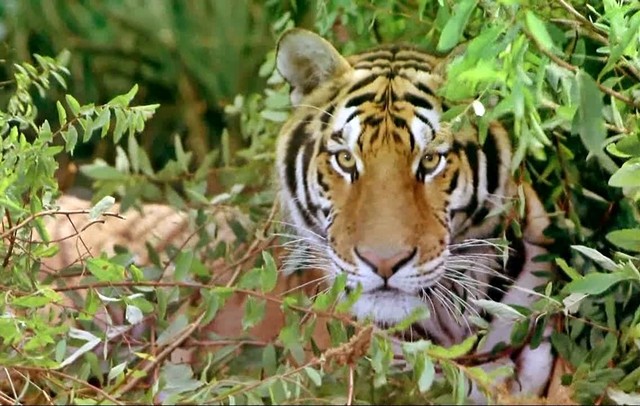
By Jae-Ha Kim
Chicago Sun-Times
August 15, 2003
![]()
Ghandi once said, “A society can be judged by the way it treats its animals.”
But what if the animal is a danger to society–then how is it to be treated?
In “India: Kingdom of the Tiger”–the latest IMAX film to hit Navy Pier–filmmaker Bruce Neibaur explores this question in a succinct 40-minute film. While the facts revealed won’t surprise anyone who’s familiar with the Discovery Channel, it still will take moviegoers on a fascinating journey.
Don’t blink, even when the tiger seemingly jumps out at you. You won’t want to miss one second of the gorgeous cinematography.
Neibaur draws viewers into the Bengal tiger’s lair with the story of real-life adventurer Jim Corbett. Once a revered tiger hunter who was called in whenever tigers attacked too many locals, he later became the tiger’s staunchest supporter. Instead of shooting to kill with his rifle, he began shooting to preserve with his camera.
More than 40,000 tigers once prowled India in the early 20th century. But during the Raj period, tens of thousands of Bengals were hunted and killed for their pelts. Hunting tigers was the nobleman’s sport of choice, and killing them was a rite of passage for young princes.
While outlawed today, tigers worldwide have fallen prey to poachers and, just as important, the loss of natural habitat. The typical male tiger stakes out 25 square miles of territory for himself. Today, there are less than 3,000 of these magnificent creatures battling for precious space with India’s 1 billion human inhabitants.
Thanks in large part to Corbett’s work, the first of 23 national parks to preserve tigers was opened in India in 1957.
The majestic tiger also has wrongfully earned the title of maneater. In reality, the only tigers looking for a scrawny human buffet are the ones who are too old or weak to hunt faster prey.
Unlike lions, which are social animals, tigers are loners. The mother shoos her cubs away when they reach 18 months of age. The white spots on the back of their ears help them from early death, because it is believed predators mistake them for the whites of the eyes.
The chase scenes are thrilling, but the film is most successful when Neibaur depicts the day-to-day “boring” moments–the tigers napping in the sun, lapping up water and staring pensively and directly at the camera. On screen, the tigers may look deceptively mellow at times.
It doesn’t occur to you that these well-muscled frisky critters often weigh between 400 to 500 pounds and reach 10 feet in length (from nose to the tip of the tail) and that their powerful paws could snap you like a twig, should they decide to chase you.





